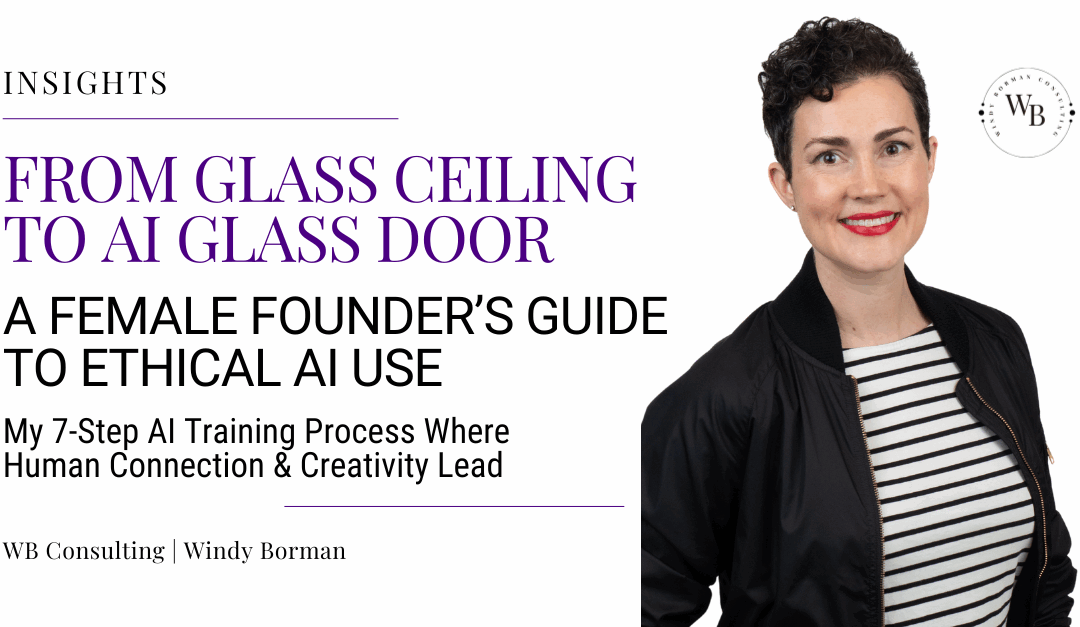Picture this: You finally escape the corporate glass ceiling by starting your own company, only to find AI threatening to automate your entire marketing team. Welcome to 2025, where the very tools promising “freedom” could trap us all over again.
As a female founder, I’m passionate about storytelling that entertains, educates, and empowers change. But “moving fast and breaking things” isn’t ethical or sustainable. So, let’s be honest about AI’s double-edged sword.
The Numbers Tell a Stark Story
Recent studies reveal troubling trends across multiple dimensions:
- Nearly 79% of working women (about 59 million) are in occupations susceptible to disruption and automation.
- Marketing managers face a 58.5% exposure score to AI disruption.
- Women are adopting AI tools at a 25% lower rate than men.
The pain points compound for women. We already earn less—in 2024, women earned an average of 85% of what men earned—and the gap widens dramatically for women of color. Hispanic women earned just 57 cents and Black women earned 64 cents for every dollar earned by white, non-Hispanic men in 2020. Now, AI disruption threatens the very occupations where women have found their foothold.
How can we do more with less when we start with less?
The Entrepreneurial Escape Turned Trap
Many female founders started businesses to shatter the glass ceiling—that invisible barrier that can prevent talented women from senior leadership roles. Or we faced the glass cliff—where women are appointed to the top job in a crisis, leading failing organizations with a higher risk of failure.
Research around pay disparity and leadership positions indicates that as women get older, they experience greater levels of age discrimination than their male counterparts.
The irony is that we fled one glass structure only to face another.
The AI Environmental and Human Cost
Before diving into my AI approach, let’s address the elephant in the room: sustainability. Training LLMs like GPT-3 consumed electricity equivalent to 500 metric tons of carbon, equaling 1.1 million pounds. A ChatGPT query needs nearly 10 times as much electricity as a Google search.
These environmental costs disproportionately impact developing nations. Resource extraction and power-hungry AI data centers in the Global South damage ecosystems already impacted by climate change. Kenyan workers training content filters for OpenAI’s ChatGPT earned less than $2 an hour—raising serious climate justice and human rights concerns. Some refer to this phenomenon as “AI Colonialism“.
Given these realities, I believe we should use AI sparingly and ethically.
What’s a Founder To Do?
But I also recognize that AI is here to stay. I don’t want my business to fail because I refused to adapt and innovate. As someone with a background in teaching and documentary filmmaking, my core mission has always been to empower others through education. That’s why I want to share how I trained Claude to be my AI copywriter.
This approach makes me more efficient and helps me scale my business faster, but with one crucial distinction: Claude may be my AI Copywriter, but I am the Editor and Creative Director of my brand.
Here’s my seven-step framework for thoughtful AI integration:
My Seven-Step AI Training Process
Step 1: Deep Brand Immersion
I started by teaching AI my unique “Rockstar” personality and BRAVE brand voice. Why? Because authentic voice can’t be automated. This creates guardrails ensuring AI enhances rather than replaces my perspective. It’s about making AI speak with my voice, not letting it become my voice.
Step 2: Comprehensive Market Research
I fed AI deep insights about my ideal clients’ pain points and journal entries about their struggles. This humanizes the data. AI learns not just demographics but the emotional landscape of female founders facing tech displacement. It’s about teaching AI empathy through data.
Step 3: Service Package Alignment
I structured AI to understand my consulting services ecosystem. This prevents generic content creation and ensures every piece naturally leads prospects toward meaningful human engagement. AI becomes a pathway to connection, not a replacement for it.
Step 4: Proof Point Collection
I uploaded testimonials and client interviews, teaching AI to reference real human experiences. This creates content grounded in authentic transformations, not algorithmic assumptions. Human stories remain at the center, with AI as the amplifier.
Step 5: Industry Trend Integration
I provided current research on social media trends and AI impact studies, helping AI contextualize its suggestions within our changing landscape. This creates content that acknowledges reality while offering hope.
Step 6: Strategic Framework Adoption
I shared my proven methodologies, ensuring AI recommendations align with my ethical approach to technology. This prevents the tool from suggesting strategies that conflict with my values around human creativity and connection.
Step 7: Content Planning Templates
I created templates that embed my systematic thinking, helping AI replicate my strategic approach across platforms. This maintains consistency while allowing for scale without sacrificing authenticity.
The Reality: Human Creativity Still Leads
While AI helps me scale, nothing replaces human creativity when it comes to truly entertaining, educating, and empowering change. AI is just one tool in my storytelling toolbox—helpful for efficiency but never a substitute for genuine human connection.
Building an Ethical AI Community
I’m passionate about creating a community of female founders who use AI ethically and sparingly. Together, we can navigate this technological shift while protecting our values, our teams, and our planet.
Join the conversation:
- What’s your biggest concern about using AI in your business?
- How do you balance efficiency with ethics?
- If you could design AI tools specifically for women-led businesses, what ethical guardrails would you build in?
Share your thoughts. Let’s build a supportive community around responsible AI use.


